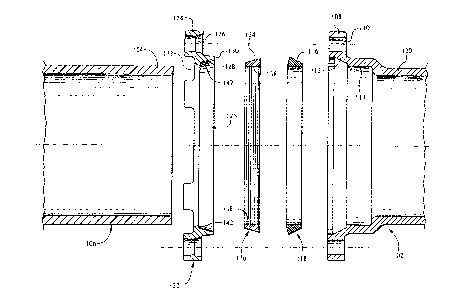Some of the information on this Web page has been provided by external sources. The Government of Canada is not responsible for the accuracy, reliability or currency of the information supplied by external sources. Users wishing to rely upon this information should consult directly with the source of the information. Content provided by external sources is not subject to official languages, privacy and accessibility requirements.
Any discrepancies in the text and image of the Claims and Abstract are due to differing posting times. Text of the Claims and Abstract are posted:
| (12) Patent: | (11) CA 2130777 |
|---|---|
| (54) English Title: | MECHANICAL PIPE JOINT |
| (54) French Title: | JOINT MECANIQUE DE TUYAU |
| Status: | Term Expired - Post Grant Beyond Limit |
| (51) International Patent Classification (IPC): |
|
|---|---|
| (72) Inventors : |
|
| (73) Owners : |
|
| (71) Applicants : |
|
| (74) Agent: | KIRBY EADES GALE BAKER |
| (74) Associate agent: | |
| (45) Issued: | 1998-09-22 |
| (22) Filed Date: | 1994-08-24 |
| (41) Open to Public Inspection: | 1995-05-17 |
| Examination requested: | 1995-11-30 |
| Availability of licence: | N/A |
| Dedicated to the Public: | N/A |
| (25) Language of filing: | English |
| Patent Cooperation Treaty (PCT): | No |
|---|
| (30) Application Priority Data: | ||||||
|---|---|---|---|---|---|---|
|
An improved mechanical pipe joint for use in a bell
and plain pipe end assembly. The joint includes a gland
having a conical cavity for receiving a toothed split ring
that coaxially compresses and grips the plain pipe end as
the gland is tightened to the bell. The joint is sealed by
a compressible gasket positioned between the split ring and
the bell. The gland further includes an integrally formed,
radially extending shelf for abutting against the split
ring and mechanically stopping the gland from being pulled
over the split ring during joint assembly.
Cette invention concerne un joint mécanique amélioré pour l'assemblage de tuyaux à emboîtement ordinaires. Le joint comprend un fouloir dans la cavité conique de laquelle se loge une bague fendue crénelée qui comprime radialement le bout uni du tuyau et s'y accroche à mesure le fouloir est serré contre le bout évasé du tuyau adjacent. L'étanchéité est réalisée par un joint compressible placé entre la bague fendue et le bout évasé. Le fouloir comprend en outre un épaulement radiale qui s'appuie contre la bague fendue et empêche le fouloir de la dépasser à l'assemblage.
Note: Claims are shown in the official language in which they were submitted.
Note: Descriptions are shown in the official language in which they were submitted.

2024-08-01:As part of the Next Generation Patents (NGP) transition, the Canadian Patents Database (CPD) now contains a more detailed Event History, which replicates the Event Log of our new back-office solution.
Please note that "Inactive:" events refers to events no longer in use in our new back-office solution.
For a clearer understanding of the status of the application/patent presented on this page, the site Disclaimer , as well as the definitions for Patent , Event History , Maintenance Fee and Payment History should be consulted.
| Description | Date |
|---|---|
| Inactive: Expired (new Act pat) | 2014-08-24 |
| Inactive: IPC from MCD | 2006-03-11 |
| Inactive: IPC from MCD | 2006-03-11 |
| Inactive: Late MF processed | 2005-09-01 |
| Letter Sent | 2005-08-24 |
| Letter Sent | 2004-12-01 |
| Letter Sent | 2001-09-07 |
| Grant by Issuance | 1998-09-22 |
| Pre-grant | 1998-04-14 |
| Inactive: Final fee received | 1998-04-14 |
| Letter Sent | 1997-10-15 |
| Notice of Allowance is Issued | 1997-10-15 |
| Notice of Allowance is Issued | 1997-10-15 |
| Inactive: Status info is complete as of Log entry date | 1997-10-09 |
| Inactive: Application prosecuted on TS as of Log entry date | 1997-10-09 |
| Inactive: IPC removed | 1997-08-22 |
| Inactive: First IPC assigned | 1997-08-22 |
| Inactive: IPC assigned | 1997-08-22 |
| Inactive: Approved for allowance (AFA) | 1997-08-13 |
| All Requirements for Examination Determined Compliant | 1995-11-30 |
| Request for Examination Requirements Determined Compliant | 1995-11-30 |
| Application Published (Open to Public Inspection) | 1995-05-17 |
There is no abandonment history.
The last payment was received on 1998-08-17
Note : If the full payment has not been received on or before the date indicated, a further fee may be required which may be one of the following
Patent fees are adjusted on the 1st of January every year. The amounts above are the current amounts if received by December 31 of the current year.
Please refer to the CIPO
Patent Fees
web page to see all current fee amounts.
Note: Records showing the ownership history in alphabetical order.
| Current Owners on Record |
|---|
| TYLER PIPE INDUSTRIES |
| Past Owners on Record |
|---|
| MINOR W. PANNELL |
| OLIN I. JACKSON |
| THOMAS D. HUNTER |